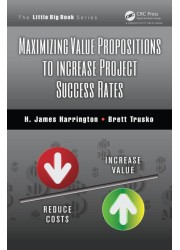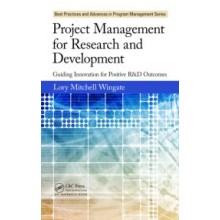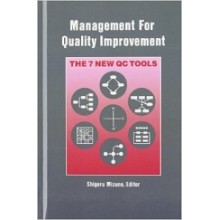Maximizing Value Propositions to Increase Project Success Rates
Quantity:
-
Add to Compare
Value proposition, an old concept, is taking on new significance in today’s innovation-driven environment. Business focus has shifted from developing many creative ideas to developing only those that will successfully flow through the product cycle and fulfill a customer need.
The old approach resulted in less than a 10 percent success rate for concepts that started through the product cycle; this can no longer be tolerated. This new book on value propositions outlines a systematic approach to making an early evaluation of potential projects and programs so you can determine if they can add real value to your organization or its customers—potentially saving you millions of dollars and months of valuable time.
Focusing on the necessary data collection efforts, Maximizing Value Propositions to Increase Project Success Rates will help you identify easy opportunities for improvement and will guide you through the process of creating value propositions for the ideas that will drive the organization’s future profits. It outlines a four-stage approach to creating value propositions and explains how to create effective value proposition documents.
The book illustrates the role of the opportunity center in capturing new ideas, describes how to present value propositions to management, and includes an example of a new product value proposition. Detailing a method for continuous review of the improvement process, it will help you foster an entrepreneurial mind-set within your employees and encourage them to actively search and document value-adding ideas.
Through the effective use of value propositions it is completely possible for your organization to increase the number of new products/services it offers to your customers by over 100 percent. It is not unusual for this to result in more than a 40 percent increase in profits per year. Adopting the approach outlined in the text for using value propositions can save your organizations millions of dollars and much time. What could be better than reducing costs while increasing sales?
Table of Contents
Importance of Value Propositions
Introduction
Definitions
Summary
The Opportunity Center: A New Approach to Capture Ideas and Concepts
Introduction
How Does the Suggestion Program Work?
Japanese Suggestion Activities
Why Is the Japanese Suggestion System So Much More Effective than the American System?
Role of the Opportunity Center
Typical Objectives of the Opportunity Center
Knowledge Management as Part of the Opportunity Center
Reinforcing the Opportunity Environment
Summary
The Value Proposition
Introduction
Four-Stage Approach
Three Levels of Improvement
Three Performance Issues
Summary
Stage I—Identifying New or Revised Product or Improvement Proposals
Introduction
Stage I. Activity 1—Conduct a Benchmarking Process Study
Input A. Processes/Products/Services Targeted for Benchmarking
Planning for Benchmarking and Secondary Research
Consulting Internal Sources
Conducting Secondary Research
Benchmarking Resources
Surveying Secondary Resources
Use Available Benchmarking Resources
Evaluate the Quality of Information Obtained and Modify the Search
Identifying Benchmarking Partners
Benchmarking Arrangement
Refine Benchmarking Data Collection Plan
Pretest the Data Collection Plan
Refine the Benchmarking Data Collection Plan
Obtaining Sign-Off on the Benchmarking Data
Collection Plan
Collect Benchmarking Data
Identify Performance Issue Best Practices
Conduct a Formal Review of Benchmarks and Leading Practices
Stage I. Activity 2—Performing the Gap Analysis
Stage I. Activity 3—Is There Sufficient Gap to Take Action?
Focus on Performance Gaps and Their Causes and Benchmarking Reports
Prepare a Research Paper Related to a New or Modified Product
Communicate the Organization’s Actual Position and Performance to the Executive Team
Business Process Redesign
Conduct Formal Review of Performance Gap Analysis—Is This Viable?
Stage I. Activity 4—No Action Is Required if There Are No, or Very Minimal, Gaps
Stage I Comment
Input B. Research Projects Previously Identified
Stage I. Activity 5—Prepare Research Paper Related to New/Modified Product
Stage I. Activity 6—Conduct Market Analysis Study
Stage I. Activity 7—Is This a Viable Product?
Stage I. Activity 8—If It Is Not a Viable Product, Terminate the Study
Input C. Random Ideas/Concepts Generated Inside or Outside the Organization
Stage I. Activity 9—Document Idea or Concept Change Proposals
Summary
Stage II—Opportunity Analysis
Introduction
Stage II. Activity 10—Collect New or Revised Product/Service or Improvement Proposals
Stage II. Activity 11—Does the Proposal Meet the Ground Rules to Prepare a Value Proposition?
Stage II. Activity 12—If the Answer Is No, Then Take Appropriate Action
Stage II. Activity 13—Assign a VPP Team and Familiarize It with the Proposed Project Management Documents
Stage II. Activity 14—Collect Required Data
What Are the Benefits of Implementing the Opportunity?
What Are the Possible Adverse Effects If the Change Occurs?
How Will the Change Affect the Overall Business and Is the Business Prepared to Accept Those Changes?
Evaluate the Opportunity
Gathering the Opportunity Analysis Information
Summary
Stage III—Preparing the Value Proposition
Stage III. Activity 15—Prepare the Value Proposition Document
Executive Overview
List of the Key People Associated with the Value
Proposition
Financial Calculations
Details Related to Other Value-Added Results
List of Risks and Exposures
List of Assumptions
Other Solutions That Were Considered
Implementation Plan
Three-Year Impact If Proposed Change Is Not Approved
Net Value Added
Detailed Recommendations
References
Review of the Value Proposition Document
Proposed Process Modification Value Proposition Example
Example of New Product Value Proposition
Summary
Stage IV—Value Proposition Presentation
Introduction
Stage IV. Activity 16—Present Value Proposition to Management
Assemble Value Proposition
Review Value Proposition
Obtain Management Direction Related to the Value Proposition
Publish the Value Proposition
Stage IV. Activity 17—Management Review Outcome
Stage IV. Activity 18—Hold for Business Case to Be Prepared
Stage IV. Activity 19—Rejected/Activity Dropped
Stage IV. Activity 20—Implement Using Current Resources
Assess Stage Results
Reconcile with Organization’s Knowledge Base
Summary
Write a review
Your Name:Your Review: Note: HTML is not translated!
Rating: Bad Good
Enter the code in the box below:
Copyright © 2014 Engineering Standards Bureau. All Rights Reserved.
Developed By Zoom Into Web







